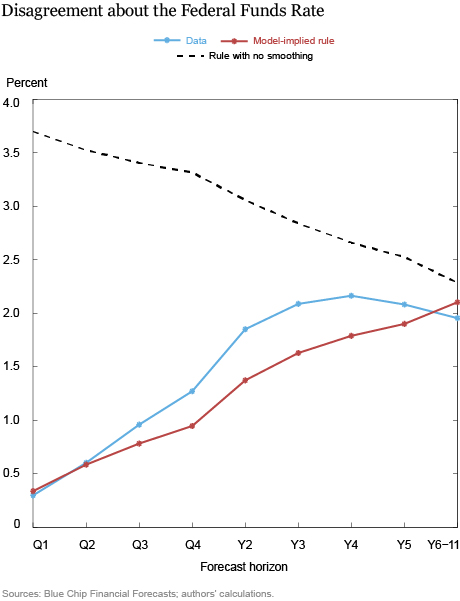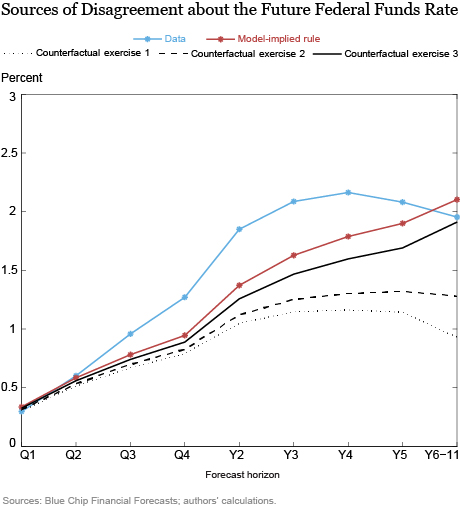What can disagreement teach us about how private forecasters perceive the conduct of monetary policy? In a previous post, we showed that private forecasters disagree about both the short-term and the long-term evolution of key macroeconomic variables but that the shape of this disagreement differs across variables. In contrast to their views on other macroeconomic variables, private forecasters disagree substantially about the level of the federal funds rate that will prevail in the medium to long term but very little on the rate at shorter horizons. In this post, we explore the possible explanations for what drives forecasts of the federal funds rate, especially in the longer run.
What Are the Rules?
Monetary policy rules are a common way to summarize, with an equation, the policy decisions of central banks. For the United States, a commonly used rule links the current value of the federal funds rate to its past value plus three additional components: (1) the deviation of inflation from the long-run goal; (2) the deviation of current economic output growth from its sustainable level; and (3) the long-run equilibrium policy rate. “Smoother” policy rules tend to put more weight on recent levels of the federal funds rate. Conversely, versions that put more weight on the gaps in output and inflation yield more volatile policy paths.
We can use the concept of a policy rule to discover which dimensions of policy cause the most disagreement among private forecasters. For example, does disagreement about the path of the federal funds rate reflect disagreement about the growth prospects of the United States, inflation, or both? Are the sources of disagreement the same for short-term and long-term forecasts?
In the chart below, the blue line shows the average disagreement for the federal funds rate from 1986-2013 for private forecasts ranging from one quarter ahead (Q1) to 6-11 years ahead (Y6-11). The forecast disagreement comes from the Blue Chip Financial Forecasts (BCFF) survey, which we have used in a number of other posts
(see
here,
here,
here, and
here).
The red line shows the disagreement we would have observed if private forecasters used a policy rule as described above to form their federal funds rate forecasts. We use their individual forecasts for output, inflation, and the longer-run level of the federal funds rate as components of the policy rule (see full details in this paper ).
This simple rule does an excellent job capturing the key features of observed disagreement. First, disagreement about the next few quarters is low, and at one and two quarters ahead the forecasts are very similar. In contrast, forecasters disagree considerably about the medium and long term.

So what could explain this upward slope in the “term structure” of disagreement? One natural response could be that it is always easier to forecast nearer in the future than further in the future. But as we showed in our previous post, this is not true for output and inflation forecasts. In fact, forecasters disagree more about output growth one quarter ahead than eleven years ahead. The policy rule that characterizes forecasters’ perception of monetary policy is quite inertial—that is, the policy rate responds gradually to changing economic conditions—so the federal funds rate a few quarters out is more predictable because it is highly dependent on the current federal funds rate. At longer horizons, the current level of the federal funds rate is a lot less informative and so disagreement is higher. To drive the point home, the dashed line in the chart shows disagreement from a rule when there is no inertia in policy. We can see that the shape of the term structure is exactly reversed—disagreement declines at longer horizons.
As we move to the longest horizons, the third component of the policy rule, the equilibrium policy interest rate, is the main determinant of disagreement because the output and inflation gaps are likely to be very small.
The Policy Rate in the Long Run
So what determines the equilibrium policy rate? Essentially three factors: (1) the long-run growth rate of the economy, (2) the long-run inflation rate; and (3) willingness to save here and abroad.
In the next chart, we consider a few counterfactual exercises to gauge which of these factors has caused the most forecaster disagreement over the last twenty-five years.

The dotted line corresponds to an environment in which there is no disagreement about the long-run equilibrium rate. In this case, the model-implied disagreement falls well short of the observed disagreement. The dashed line shows the model-implied disagreement when the only disagreement about the long-run equilibrium rate reflects disagreement about the long-run inflation rate. This improves the fit only marginally, suggesting that Fed credibility
(about its commitment to stable prices) is not the main source of disagreement about the equilibrium rate. Now suppose we allow for disagreement about both inflation and long-run growth. For example, the current debate about “secular stagnation
” suggests substantial disagreement about the long-run prospects of the U.S. economy. The black line shows that when we add disagreement about long-run growth, we almost match observed disagreement from private forecasters.
The longer-run growth prospects of an economy are a key determinant of monetary policy. These simple exercises have shown that private forecasters’ disagreement about growth prospects are in turn a key determinant to their disagreement about monetary policy in the medium term.
Disclaimer
The views expressed in this post are those of the authors and do not necessarily reflect the position of the Federal Reserve Bank of New York or the Federal Reserve System. Any errors or omissions are the responsibility of the authors.
 Richard K. Crump is an assistant vice president in the Federal Reserve Bank of New York’s Research and Statistics Group.
Richard K. Crump is an assistant vice president in the Federal Reserve Bank of New York’s Research and Statistics Group.

Stefano Eusepi is also an assistant vice president in the Group.
How to cite this blog post:
Richard K. Crump and Stefano Eusepi, “What Drives Forecaster Disagreement about Monetary Policy?” Federal Reserve Bank of New York Liberty Street Economics (blog), August 15, 2016, http://libertystreeteconomics.newyorkfed.org/2016/08/what-drives-forecaster-disagreement-about-monetary-policy.html.















 RSS Feed
RSS Feed Follow Liberty Street Economics
Follow Liberty Street Economics
Given what it is said here, wouldn’t it make sense for the Fed to give a more positive on the economy rather than always talking about downside risks? Maybe by doing so it could help push the economy while at the same time allowing for long term rates to move to less absurd levels